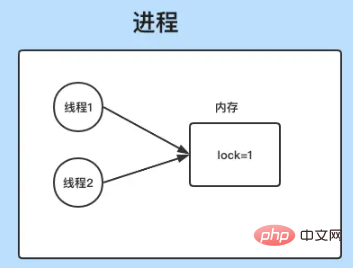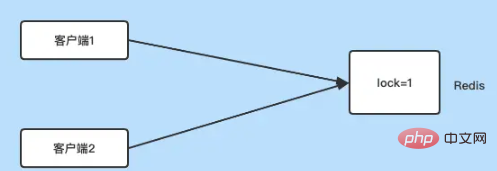An article explaining in detail how to use Redis to implement distributed locks
Recommended learning: Redis video tutorial
1. What is a distributed lock
When we write multi-threaded code, different threads may compete for resources. In order to avoid errors caused by resource competition, we will lock the resources. Only the thread that has obtained the lock can continue to execute.
The lock in the process is essentially a variable in the memory. When a thread performs an operation to apply for a lock, if it can successfully set the value of the variable representing the lock to 1, it means that the lock has been obtained. Others The thread will block when it wants to obtain the lock. After the thread owning the lock completes the operation, it sets the value of the lock to 0, which means the lock is released.

What we are talking about above is the lock between different threads in the process of a server. This lock is placed in the memory, and for distributed applications Say, different applications (processes or threads) are deployed on different servers, so locks cannot be represented by variables in memory.
Since the lock can be represented by the shared memory space on a server, for distributed applications, a shared storage system can be used to store a shared lock. This is a distributed lock. As an in-memory database, Redis executes very quickly and is very suitable as a shared storage system for implementing distributed locks.

2. Use Redis to implement distributed locks
For a lock, there are actually only two operations, locking and releasing the lock. Let’s look at it below. Let’s see how to achieve it through Redis?
2.1 The setnx
command of locking#Redis will determine whether the key value exists. If it exists, nothing will be done. operation, and returns 0. If it does not exist, create and assign a value, and return 1, so we can execute setnx to set a value for a representative lock key. If the setting is successful, it means the lock is obtained. If it fails, Unable to acquire lock.
# 使用key为lock来表示一个锁 setnx lock 1
2.2 Release the lock
After the operation is performed, when you want to release the lock, directly change the key value in Redislock Just delete it, so that other processes can reset and obtain the lock through the setnx command.
# 释放锁 del lock
Through the above two commands, we have implemented a simple distributed lock, but there is a problem here: if a process is locked through the setnx command, after executing the specific If the operation goes wrong and there is no way to release the lock in time, then other processes will not be able to obtain the lock, and the system will not be able to continue execution. The way to solve this problem is to set a validity period for the lock, and after this validity period, the lock will be automatically released.
2.3 Set the validity period for the lock
It is very simple to set the validity period for the lock. Just use the expire command of Redis , such as:
# 加锁 setnx lock 1 # 给锁设置10s有效期 expire lock 10
However, another problem arises now. If after setting the lock, the process hangs before executing the expire command, then expire If the execution is not successful, the lock has not been released, so we must ensure that the above two commands are executed together. How to ensure this?
There are two methods, one is a script written in LUA language, and the other is using the set command of Redis, When the set command is followed by the nx parameter, the execution effect is consistent with setnx, and the set command can be followed by the ex parameter. Set the expiration time, so we can use the set command to merge the setnx and expire together, so that the atomicity of execution can be guaranteed.
# 判断是否键值是否存在,ex后面跟着的是键值的有效期,10s set lock 1 nx ex 10
Having solved the problem of effective locks, now let’s look at another problem.

As shown in the picture above, there are now processes on three different servers: A, B, C To perform an operation, you need to obtain a lock and release the lock after execution.
现在的情况是进程A执行第2步时卡顿了(上面绿色区域所示),且时间超出了锁有效期,所以进程A设置的锁自动释放了,这时候进程B获得了锁,并开始执行操作,但由于进程A只是卡顿了而已,所以会继续执行的时候,在第3步的时候会手动释放锁,但是这个时候,锁由线程B所拥有,也就是说进程A删除的不是自己的锁,而进程B的锁,这时候进程B还没执行完,但锁被释放后,进程C可以加锁,也就是说由于进程A卡顿释放错了锁,导致进程B和进程C可以同时获得锁。
怎么避免这种情况呢?如何区分其他进程的锁,避免删除其他进程的锁呢?答案就是每个进程在加锁的时候,给锁设置一个唯一值,并在释放锁的时候,判断是不是自己设置的锁。
2.4 给锁设置唯一值
给锁设置唯一值的时候,一样是使用set命令,唯一的不同是将键值1改为一个随机生成的唯一值,比如uuid。
# rand_uid表示唯一id set lock rand_id nx ex 10
当锁里的值由进程设置后,释放锁的时候,就需要判断锁是不是自己的,步骤如下:
- 通过
Redis的get命令获得锁的值 - 根据获得的值,判断锁是不是自己设置的
- 如果是,通过
del命令释放锁。
此时我们看到,释放锁需要执行三个操作,如果三个操作依次执行的话,是没有办法保证原子性的,比如进程A在执行到第2步后,准备开始执行del命令时,而锁由时有效期到了,被自动释放了,并被其他服务器上的进程B获得锁,但这时候线程A执行del还是把线程B的锁给删掉了。
解决这个问题的办法就是保证上述三个操作执行的原子性,即在执行释放锁的三个操作中,其他进程不可以获得锁,想要做到这一点,需要使用到LUA脚本。
2.5 通过LUA脚本实现释放锁的原子性
Redis支持LUA脚本,LUA脚里的代码执行的时候,其他客户端的请求不会被执行,这样可以保证原子性操作,所以我们可以使用下面脚本进行锁的释放:
if redis.call("get",KEYS[1]) == ARGV[1] then
return redis.call("del",KEYS[1])
else
return 0
end将上述脚本保存为脚本后,可以调用Redis客户端命令redis-cli来执行,如下:
# lock为key,rand_id表示key里保存的值 redis-cli --eval unlock.lua lock , rand_id
推荐学习:Redis视频教程
The above is the detailed content of An article explaining in detail how to use Redis to implement distributed locks. For more information, please follow other related articles on the PHP Chinese website!

Hot AI Tools

Undresser.AI Undress
AI-powered app for creating realistic nude photos

AI Clothes Remover
Online AI tool for removing clothes from photos.

Undress AI Tool
Undress images for free

Clothoff.io
AI clothes remover

Video Face Swap
Swap faces in any video effortlessly with our completely free AI face swap tool!

Hot Article

Hot Tools

Notepad++7.3.1
Easy-to-use and free code editor

SublimeText3 Chinese version
Chinese version, very easy to use

Zend Studio 13.0.1
Powerful PHP integrated development environment

Dreamweaver CS6
Visual web development tools

SublimeText3 Mac version
God-level code editing software (SublimeText3)

Hot Topics
 1664
1664
 14
14
 1422
1422
 52
52
 1316
1316
 25
25
 1268
1268
 29
29
 1240
1240
 24
24
 How to build the redis cluster mode
Apr 10, 2025 pm 10:15 PM
How to build the redis cluster mode
Apr 10, 2025 pm 10:15 PM
Redis cluster mode deploys Redis instances to multiple servers through sharding, improving scalability and availability. The construction steps are as follows: Create odd Redis instances with different ports; Create 3 sentinel instances, monitor Redis instances and failover; configure sentinel configuration files, add monitoring Redis instance information and failover settings; configure Redis instance configuration files, enable cluster mode and specify the cluster information file path; create nodes.conf file, containing information of each Redis instance; start the cluster, execute the create command to create a cluster and specify the number of replicas; log in to the cluster to execute the CLUSTER INFO command to verify the cluster status; make
 How to clear redis data
Apr 10, 2025 pm 10:06 PM
How to clear redis data
Apr 10, 2025 pm 10:06 PM
How to clear Redis data: Use the FLUSHALL command to clear all key values. Use the FLUSHDB command to clear the key value of the currently selected database. Use SELECT to switch databases, and then use FLUSHDB to clear multiple databases. Use the DEL command to delete a specific key. Use the redis-cli tool to clear the data.
 How to read redis queue
Apr 10, 2025 pm 10:12 PM
How to read redis queue
Apr 10, 2025 pm 10:12 PM
To read a queue from Redis, you need to get the queue name, read the elements using the LPOP command, and process the empty queue. The specific steps are as follows: Get the queue name: name it with the prefix of "queue:" such as "queue:my-queue". Use the LPOP command: Eject the element from the head of the queue and return its value, such as LPOP queue:my-queue. Processing empty queues: If the queue is empty, LPOP returns nil, and you can check whether the queue exists before reading the element.
 How to configure Lua script execution time in centos redis
Apr 14, 2025 pm 02:12 PM
How to configure Lua script execution time in centos redis
Apr 14, 2025 pm 02:12 PM
On CentOS systems, you can limit the execution time of Lua scripts by modifying Redis configuration files or using Redis commands to prevent malicious scripts from consuming too much resources. Method 1: Modify the Redis configuration file and locate the Redis configuration file: The Redis configuration file is usually located in /etc/redis/redis.conf. Edit configuration file: Open the configuration file using a text editor (such as vi or nano): sudovi/etc/redis/redis.conf Set the Lua script execution time limit: Add or modify the following lines in the configuration file to set the maximum execution time of the Lua script (unit: milliseconds)
 How to use the redis command line
Apr 10, 2025 pm 10:18 PM
How to use the redis command line
Apr 10, 2025 pm 10:18 PM
Use the Redis command line tool (redis-cli) to manage and operate Redis through the following steps: Connect to the server, specify the address and port. Send commands to the server using the command name and parameters. Use the HELP command to view help information for a specific command. Use the QUIT command to exit the command line tool.
 How to implement redis counter
Apr 10, 2025 pm 10:21 PM
How to implement redis counter
Apr 10, 2025 pm 10:21 PM
Redis counter is a mechanism that uses Redis key-value pair storage to implement counting operations, including the following steps: creating counter keys, increasing counts, decreasing counts, resetting counts, and obtaining counts. The advantages of Redis counters include fast speed, high concurrency, durability and simplicity and ease of use. It can be used in scenarios such as user access counting, real-time metric tracking, game scores and rankings, and order processing counting.
 How to set the redis expiration policy
Apr 10, 2025 pm 10:03 PM
How to set the redis expiration policy
Apr 10, 2025 pm 10:03 PM
There are two types of Redis data expiration strategies: periodic deletion: periodic scan to delete the expired key, which can be set through expired-time-cap-remove-count and expired-time-cap-remove-delay parameters. Lazy Deletion: Check for deletion expired keys only when keys are read or written. They can be set through lazyfree-lazy-eviction, lazyfree-lazy-expire, lazyfree-lazy-user-del parameters.
 How to optimize the performance of debian readdir
Apr 13, 2025 am 08:48 AM
How to optimize the performance of debian readdir
Apr 13, 2025 am 08:48 AM
In Debian systems, readdir system calls are used to read directory contents. If its performance is not good, try the following optimization strategy: Simplify the number of directory files: Split large directories into multiple small directories as much as possible, reducing the number of items processed per readdir call. Enable directory content caching: build a cache mechanism, update the cache regularly or when directory content changes, and reduce frequent calls to readdir. Memory caches (such as Memcached or Redis) or local caches (such as files or databases) can be considered. Adopt efficient data structure: If you implement directory traversal by yourself, select more efficient data structures (such as hash tables instead of linear search) to store and access directory information





